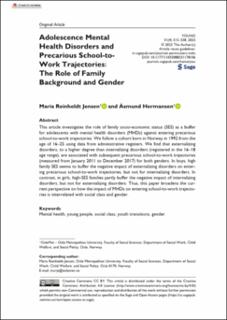| dc.contributor.author | Jensen, Maria Reinholdt | |
| dc.contributor.author | Hermansen, Åsmund | |
| dc.date.accessioned | 2023-09-13T05:38:45Z | |
| dc.date.available | 2023-09-13T05:38:45Z | |
| dc.date.created | 2023-08-11T08:04:30Z | |
| dc.date.issued | 2023 | |
| dc.identifier.citation | Young - Nordic Journal of Youth Research. 2023, 31 (4), 315-338. | en_US |
| dc.identifier.issn | 1103-3088 | |
| dc.identifier.uri | https://hdl.handle.net/11250/3088991 | |
| dc.description.abstract | This article investigates the role of family socio-economic status (SES) as a buffer for adolescents with mental health disorders (MHDs) against entering precarious school-to-work trajectories. We follow a cohort born in Norway in 1992 from the age of 16–25 using data from administrative registers. We find that externalizing disorders, to a higher degree than internalizing disorders (registered in the 16–18 age range), are associated with subsequent precarious school-to-work trajectories (measured from January 2011 to December 2017) for both genders. In boys, high family SES seems to buffer the negative impact of externalizing disorders on enter- ing precarious school-to-work trajectories, but not for internalizing disorders. In contrast, in girls, high-SES families partly buffer the negative impact of internalizing disorders, but not for externalizing disorders. Thus, this paper broadens the cur- rent perspective on how the impact of MHDs on entering school-to-work trajecto- ries is interrelated with social class and gender. | en_US |
| dc.language.iso | eng | en_US |
| dc.rights | Navngivelse 4.0 Internasjonal | * |
| dc.rights.uri | http://creativecommons.org/licenses/by/4.0/deed.no | * |
| dc.title | Adolescence Mental Health Disorders and Precarious School-to- Work Trajectories: The Role of Family Background and Gender | en_US |
| dc.type | Peer reviewed | en_US |
| dc.type | Journal article | en_US |
| dc.description.version | publishedVersion | en_US |
| cristin.ispublished | true | |
| cristin.fulltext | original | |
| cristin.qualitycode | 1 | |
| dc.identifier.doi | 10.1177/11033088231178106 | |
| dc.identifier.cristin | 2166282 | |
| dc.source.journal | Young - Nordic Journal of Youth Research | en_US |
| dc.source.volume | 31 | en_US |
| dc.source.issue | 4 | en_US |
| dc.source.pagenumber | 315-338 | en_US |
| dc.relation.project | Norges forskningsråd: 269298 | en_US |
| dc.relation.project | Norges forskningsråd: 301943 | en_US |
| dc.relation.project | Nordforsk: 83540 | en_US |
| dc.relation.project | Nordforsk: 75970 | en_US |

